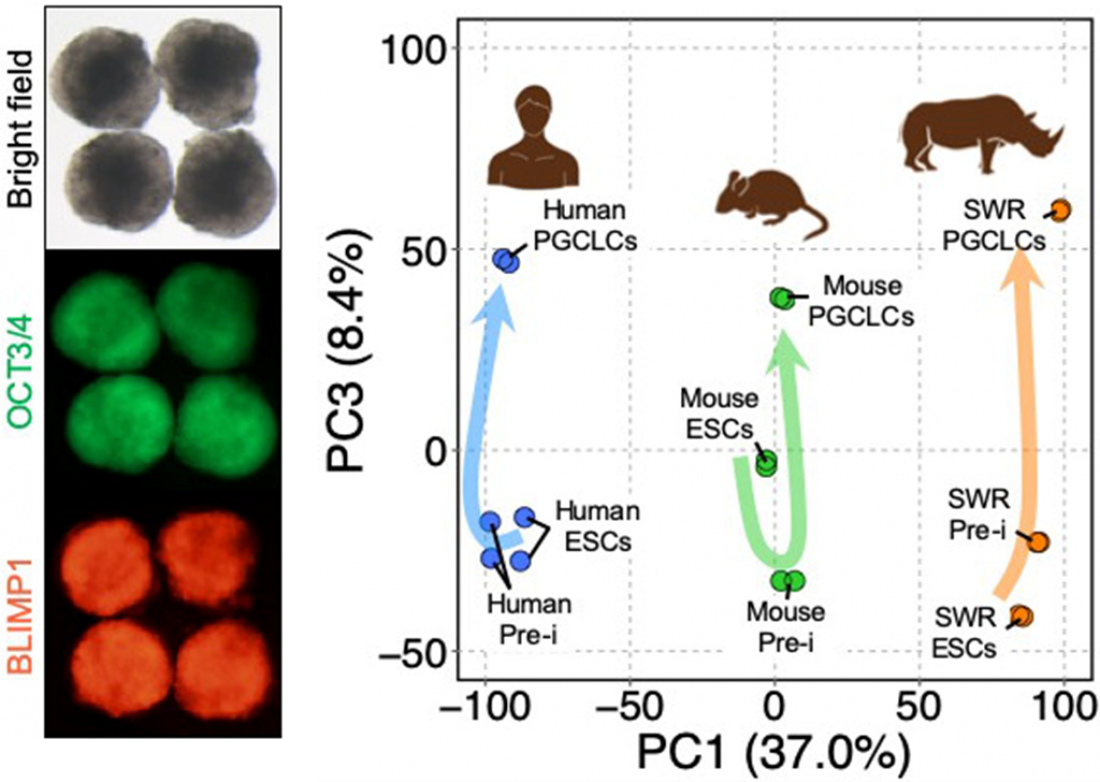PGCLCs of white rhinoceros (left) and comparison of gene expression dynamics during PGCLC differentiation among mammalian species
Researchers from Osaka University generate precursors of sperm and eggs in breakthrough for breeding programs
Osaka, Japan – For many endangered species, breeding programs are an important part of efforts to increase population numbers. Now, researchers from Osaka University have successfully induced the precursors of eggs and sperm using cells from threatened white rhinoceros, a critical step toward possibly rebuilding northern white rhino populations.
The northern white rhino, Ceratotherium simum cottoni, is extinct in the wild. Only two females remain, despite a decades-long effort to preserve the species through a breeding program alongside efforts to tackle poaching and habitat loss. The species decline outpaced conservation efforts and the last male died in 2018. Given the status of this species, new ways of approaching breeding and conservation are urgently needed.
Advanced assisted reproductive technologies developed for humans and livestock are a promising avenue for rebuilding populations of endangered species. Techniques such as artificial insemination, induction of ovulation, and in vitro culture of blastocysts have all been used. The challenge with the northern white rhino is the lack of eggs and sperm to produce embryos.
“Cells from the skin or blood can be reprogrammed back into an embryonic-like state,” explains Masafumi Hayashi, lead author of the study. “These cells are called induced pluripotent stem cells, or IPSCs. As with embryonic stem cells, they can develop into any tissue in the body, including sperm and eggs.”
Previous studies have shown that, in mice, embryonic stem cells can be differentiated into primordial germ cell-like cells (PGCLCs), which are equivalent to the origins of eggs and sperm. PGCLCs have been generated from pluripotent stem cells in mice, humans, monkeys, and rabbits, but never in wild animals.
The researchers established a culture system using pluripotent cells from southern and northern white rhinos and through repeated refinement produced PGCLCs.
“This is the first time that PGCLCs have been induced in a wild animal,” says Katsuhiko
Hayashi, senior author. “This a significant breakthrough as it paves the way for generating reproductive cells from endangered species that can then be used for breeding.”
Production of mature reproductive cells requires a cell environment that provides the chemical signals needed for sex-dependent differentiation and functional maturity of the gametes. In mice, PGCLCs were fully functional after transfer into the ovary and testis. While some challenges remain, in theory, it may be possible to produce mature northern white rhino eggs suitable for fertilization with banked sperm derived from four deceased males. For a species on the very brink of extinction, these technological advances offer hope.
###
The article, “Robust induction of primordial germ cells of white rhinoceros on the brink of extinction,” was published in Science Advances at DOI: https://www.science.org/doi/10.1126/sciadv.abp9683
About Osaka University
Osaka University was founded in 1931 as one of the seven imperial universities of Japan and is now one of Japan's leading comprehensive universities with a broad disciplinary spectrum. This strength is coupled with a singular drive for innovation that extends throughout the scientific process, from fundamental research to the creation of applied technology with positive economic impacts. Its commitment to innovation has been recognized in Japan and around the world, being named Japan's most innovative university in 2015 (Reuters 2015 Top 100) and one of the most innovative institutions in the world in 2017 (Innovative Universities and the Nature Index Innovation 2017). Now, Osaka University is leveraging its role as a Designated National University Corporation selected by the Ministry of Education, Culture, Sports, Science and Technology to contribute to innovation for human welfare, sustainable development of society, and social transformation.
Website: https://resou.osaka-u.ac.jp/en



